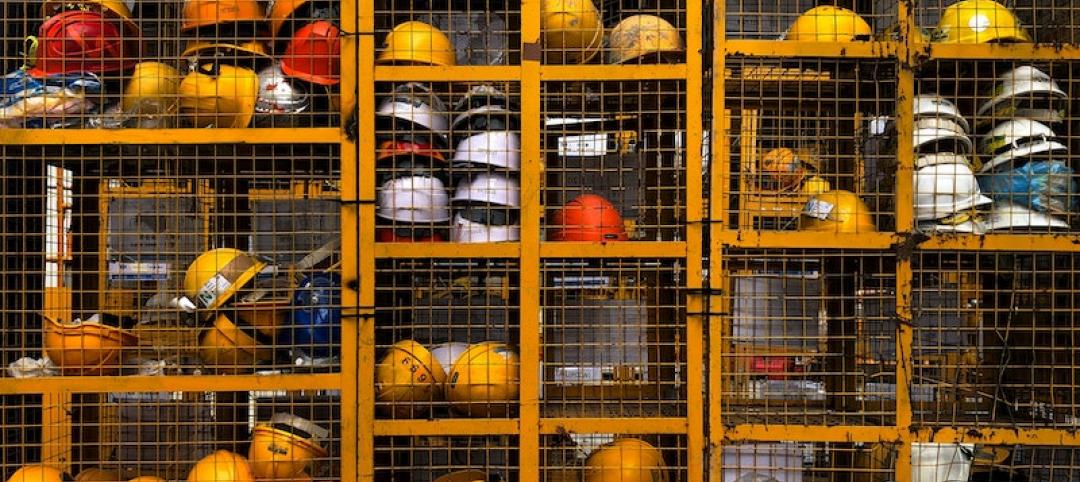The $8 trillion construction industry has a major problem. Simply put, we do not have enough people to meet construction demands worldwide. A recent study by Autodesk and the Associated General Contractors of America (AGC) found that 80% of contractors are having a difficult time finding skilled labor. Contractors leading projects today cannot find enough skilled laborers to fill the gaps left by retiring Baby Boomers.
Everyone in the industry needs to wake up to the fact that we are not going to solve the labor shortage if we continue alienating half of our potential workforce. Right now, women only make up 9% of the construction industry. This gap between men and women is notably more pronounced on jobsites, where only one of every 100 female construction professionals works in the field.
The labor shortage, combined with the world’s continued need for infrastructure, housing, and other construction investment, means that we absolutely need women to join the industry and rise the ranks within the construction workforce. This means we must shake up the status quo and overcome obstacles and excuses that previously prevented us from seeing results. Simply stating,“not enough women applied to my job posting” or “no women raised their hand for this promotion or leadership opportunity” is not good enough and no longer acceptable.
It’s time to change. It’s time to make 2019 the year we empower women in construction.
Wasn’t Women’s History Month in March?
Most likely you are wondering, why we are discussing this now—in April instead of March. An entire month after Women in Construction Week. If your LinkedIn feed was anything like mine, you saw a flurry of posts about women in construction. It was amazing, empowering, and uplifting. At the same time, it was disheartening. Women deserve to be part of the conversation for 12 months out of the year, instead of one.
Shining a light on the incredible contributions that women are making in construction and sharing the stories of female trailblazers must continue beyond March.
Encouraging women to enter the construction industry has many positive effects. Not only will construction start reaping the rewards of closing the labor gap, but a diverse workforce presents a myriad of benefits for companies, as well. According to a recent study by Forbes, diverse companies produce 19% more earnings than their counterparts. In addition to generating more revenue, diverse teams produce the following benefits:
Variety of perspectives. Regardless of gender, workers newly immersing themselves into the trades, bring fresh perspectives through their unique backgrounds, which helps companies foster more innovation and creativity. In turn, driving the industry forward.
Increased productivity. Diverse teams are productive teams. Organizations with inclusive hiring processes, generate decisions twice as fast, while spending 50% less time in meetings.
Improved performance. In the same study, Forbes found that these teams make better business decisions 87% of the time, and that those decisions delivered 60% better results.
Heightened company reputation. Women want to be in the trades. When contractors become proactive about hiring women for positions, this creates a better culture at the company and is attractive to current employees and future talent.
4 Ways We Will Make 2019 the Year for Women in Construction
Numerous diversity and inclusion initiatives already exist in 2019. Leading contractors have created mentorship programs and formal women in construction clubs. These follow in the footsteps of organizations like, 2020 Women on Boards, an active conversation based around increasing the presence of women in the C-Suite and on Corporate Boards. Additionally, groups such as NAWIC, The Federation of Women Contractors are growing in popularity.
As an engineer, I am results-oriented and data-driven. Frankly, we’re still not seeing any results yet. Why? In order for these initiatives to gain traction, there is an exceedingly important cultural change that needs to happen, empowerment. Women need to be empowered to join, and flourish, within the construction industry.
Here are four steps we must take to empower women in construction this year:
1. The majority must begin advocating for the minority. Today, industry reality is men comprise the vast majority of leadership, C-suite, and board roles. If women are to claim their opportunities, male coworkers are required as allies. The entire industry must step up, making conscious efforts and insisting on the female presence in positions of leadership and in the field.
When women have coworkers and industry leaders as allies, it’s more likely that they will find themselves in the rooms where important decisions are being made. Women will finally have the opportunity to shape the industry.
2. Women must embrace standing out. It’s a fact that we can’t avoid standing out in this industry. With the small presence of women in the current construction workforce, we are inevitably going to stand out. I urge all women to embrace it. Stand proudly and be remembered for what you want to be remembered for.
In my own experience, I’ve often been the only woman in a meeting. At industry conferences, I may be among a small handful of women in the room, and am often the only woman speaking on a panel. While these experiences could have felt isolating, I see these as opportunities to stand out. I personally realized that standing out was an advantage and in a way a super power. That’s when my career trajectory changed. No one great ever fit in with the crowd. You have to own it.
 Embracing “standing out” as an expert technology speaker. Photo: courtesy MCAA
Embracing “standing out” as an expert technology speaker. Photo: courtesy MCAA
3. The industry must amplify the voice of women. The potential for monetary achievement for women is high in the construction industry. Despite the disproportionate gender ratio of women to men, the salary gap is [shockingly] the reverse! Contrary to the rest of the workforce outside the construction industry, women, on average, earn 95.7% of what men make.
However, in order to make these jobs accessible and desirable for women, the construction industry must step forward and lean in to amplify our voice. Fortunately, there are many ways to do this. The day of the all-male panel at construction conferences is over. Diversity conscious companies today must make an increased effort to boost diversity on stage.
Diversity should also be represented in company interviews. If a candidate can’t visualize themselves in the industry, they will turn away, increasing the pipeline issue. When the entire industry leans in to focus on attracting and retaining female innovators, everyone wins.
4. Blaze your own career path within construction. Close your eyes and imagine the CEO of a Giant general contractor. Imagine an ironworker foreman on the construction of a New York skyscraper. Imagine the superintendent on a high-profile public library project. Did you imagine a woman in any of these roles? The harsh reality is that gender stereotypes and public perception about the construction industry has hindered women both entering and thriving in the construction workforce.
Today, new sets of evolving roles related to innovation, technology, virtual design, and construction exist that were not prevalent in the past decades. Chief Technology Officer, Chief Innovation Officer, Director of VDC, Technology Solutions Manager, etc., are shattering previous gender stereotypes and paving the way for a new generation of female leadership in the construction industry. Fortunately, the industry has seen incredible strides in women adopting and excelling in these roles.
Megan Conrad, Director of Virtual Construction for Ryan Companies, and Jennifer Suerth, VP of Technical Services at Pepper Construction, have blazed a trail for women in these leadership roles.
“The creation of a new niche of technology-focused roles in the construction industry has opened up opportunities for women where there was little pre-existing gender bias before. Women are leveraging this new technology-focused career path to make an impact. I believe women generally carry high emotional intelligence, patience and are extremely resourceful. These traits are perfect for technology-focused roles as active listening, brainstorming, sourcing new solutions, and working through iterations to get it right are all important assets to bringing technology adoption to the construction industry.” — Megan Conrad, Ryan Companies US
“I see the challenges with the lack of women as an opportunity, and not a roadblock. The more women we have join the industry, the more we will see real change and progress in construction. We bring a different perspective. Productivity in construction has been stagnant, and that’s due to the industry continuously trying to do things the same way they always have been. That includes who we hire and have leading our companies. While technology plays a huge role in the change we are seeing, diversity is bringing a bigger change that isn’t as obvious to everyone.” — Jen Suerth, Pepper Construction
A Call to Action
All of these initiatives for empowerment will only move the needle so far. With that in mind, my call to action to each person reading this article is to take a look around you and see who you’ve been advocating for within your organization. Who have you been mentoring, sponsoring and promoting? Take the effort to advocate for diversity. Take the first step to bring people with you on your leadership journey. This is how well drive change. It starts with you.
Reminder: These initiatives should extend far beyond gender diversity. Powerful change in our industry will only happen when we bring in and foster diversity of thought, which stems from teams containing diversity of different genders, sexual orientations, cultures, ethnicities, religions, political views, skill sets, industry backgrounds, and more.
About the Author
Danielle Dy Buncio is the Co-Founder and CEO of VIATechnik. Prior to VIATechnik Danielle managed large-scale building and infrastructure projects in Silicon Valley, Chicago, and Sydney. Danielle also serves on the Board of Directors of Ryan Companies US, a $2B real estate development, construction, and design firm. Danielle is a 2018 Building Design + Construction 40 under 40 honoree and a 2019 ENR Top Young Professional. She received a BS in Civil Engineering from Stanford and an MBA from Northwestern University Kellogg School of Management. Danielle remembers her first job site at age 3 shortly after her parents founded a heavy civil construction company in Chicago. From a young age, Danielle was fortunate to be surrounded by strong female role models in Civil Engineering and Construction including her mother, Leticia Villasenor, and her aunt, Lydia Villasenor.
VIATechnik is the global leader in virtual design and construction, with more than 150 digital experts in seven global offices. We are on a mission to transform the analog world of design and construction into a digital platform, enabling efficient design, industrialized construction, and a digital real estate service model. Through this transformation, we believe we can solve the world’s housing and infrastructure challenges, deliver spaces that nurture life, commerce, and relationships. We are proud that women at VIATechnik comprise over 30% of our team, 3X the national average. VIATechnik is a WBE firm certified by the WBENC.
More from Author
VIATechnik | Jul 17, 2023
Unlocking the power of digital twins: Maximizing success with OKRs
To effectively capitalize on digital twin technology, owners can align their efforts using objectives and key results (OKRs).
VIATechnik | Apr 19, 2022
VDC maturity and the key to driving better, more predictable outcomes
While more stakeholders across the AEC value chain embrace the concept of virtual design and construction, what is driving the vastly different results that organizations achieve? The answer lies within an assessment of VDC maturity.
VIATechnik | Sep 28, 2021
Getting diversity, equity, and inclusion going in AEC firms
As a professional services organization built on attracting the best and brightest talent, VIATechnik relies on finding new ways to do just that. Here are some tips that we’ve learned through our diversity, equity, and inclusion (DE&I) journey.
VIATechnik | Mar 2, 2021
Retail expectations vs reality in 2021
The reality of retail success in 2021 is proving to be based on a formula of mixing digital with the physical in pursuit of convenience.
VIATechnik | Nov 23, 2020
Agility is the game-changer in the post-COVID world
There has been a fundamental shift in how human beings live, work, and play. The built environment must shift in response.
VIATechnik | Nov 17, 2020
The coming automation of retail brick and mortar
The demise of retail brick and mortar is overstated and unwarranted - we see digital transformation offering brick and mortar a path forward for the physical store.
VIATechnik | Oct 1, 2020
Smart buildings stand on good data
The coming disruption of owning and operating a building and how to stay ahead through BIM.
VIATechnik | Jul 15, 2020
Building pride: A Reflection of LGBTQ rights in construction
The Supreme Court did its job. The rest is up to us.
VIATechnik | May 8, 2020
Data centers as a service: The next big opportunity for design teams
As data centers compete to process more data with lower latency, the AEC industry is ideally positioned to develop design standards that ensure long-term flexibility.
VIATechnik | Mar 17, 2020
A tree grows in Stanford: CIFE, VDC, and where it all began
As our industry adopts VDC as standard practice, it is important to remember where these ideas began and continue to emanate from today.

















